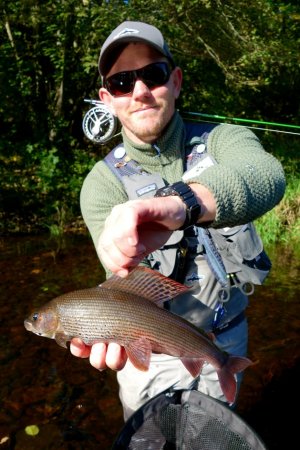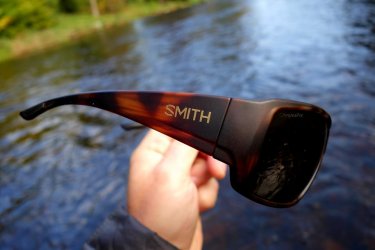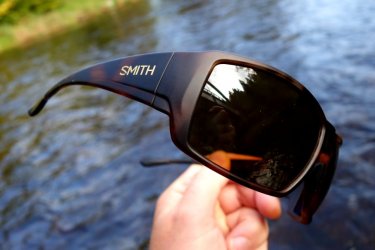Review of polarized glasses for fishermen Smith GUIDE'S CHOICE.
It's been a couple of years since my friend David Chlumsky told me that he's been planning to get a pair of Smith polarized glasses. He said they were great and that he had been thinking about them for a long time. I remember exactly what I told him at the time. Politely put, if he wasn't crazy, buy polarized glasses that expensive! And I probably said that because I didn't really know anything about the glasses and because I had never had a chance to try them on. But that has changed over the years and this summer I got the chance to try the glasses on.
David and I had just returned in the same boat from a lake training in Finland, where we represented the Czech Republic during the World Fly Fishing Championships this year. It was windy and overcast all day and the light conditions were not ideal. So I had my yellow polarized glasses on all day, which I normally use in these conditions. When we arrived at the dock, Jirka Pejchar was waiting for us. And when I saw that he was wearing SMITH sunglasses, I asked him if I could look over these world-famous glasses for a moment and try them for the first time in my life with my own eyes. As soon as I put them on, I was absolutely amazed. Suddenly, a whole different world opened up to me than I was used to in my glasses. Even in these low light conditions, with polarized glasses on, everything took on a colour, sharpness and contour that I was somehow not used to with my old glasses. Although the sky wasn't reflecting as much on the surface, everything else was just a shade of yellow, with no sharp outlines. Then, when I immediately compared my glasses to the SMITH one's several times in quick succession, I was immediately convinced that I just had to have them!
I thought about what is the most important tool in our fly fishing. And I think it's definitely our hands and eyes! And it is how we see the world around us and the world "underwater" that can determine our success while fishing. Not to mention that we don't strain our eyesight as much with these sun glasses. I suffer from a birth defect called astigmatism, where I can't see fine details and contours and the overall picture is a bit fuzzy. Especially in difficult lighting conditions. But I have learned to live with it and only wear my dioptric glasses when tying flies or in the car in the evening. But I wear polarized glasses not only when fishing, but actually almost all the time when the sun is shining just a little. And that's why I decided to get one of these SMITH glasses. Each type of SMITH glasses can be purchased with different lens colors and VLT values. I decided to get the GUIDE'S CHOICE CP GLASS model with POLAR BROWN lens colour and VLT 14%. VLT, or Visible Light Transmission, actually means how much light passes through the lenses. The higher the VLT, the lighter the lens tint. Good lighting conditions (bright and sunny) require low VLT and poor lighting conditions (overcast, morning, early evening) require higher VLT. SMITH offers a range of VLT from 9% to 50% VLT. My glasses are therefore suitable for semi-cloudy to clear weather.
These are glasses that have glass polarizing lenses. This is reflected in their price, but mainly also in their quality. In fact, the glass and maximum transparent TechliteTM lenses allow you to see the clearest image and are extremely scratch resistant. Their ChromaPop+TM treatment ensures excellent visibility of all shades of colour, contours and all fine details. And that's just fine when fishing. Because reading the water is the basis for success in fly fishing. And that means seeing as much detail as possible. When reading the water, it is important to recognize, for example, the depth by the so-called colour of the water. The darker the water, the deeper it is. And this always depends on the colour of the bottom. It is therefore very important to see all the colours of the water. You can also tell from the surface of the river where the water is slowing down and where it is speeding up. To do this, it is important to be able to see all the changes in the water surface well and especially clearly. From this we can read the fish habitat well. It is good to see all the obstacles in the water that we need to avoid with our flies and next to which we can expect fish. And last but not least, the better and sharper we can see colours and contours, the better we can see the fish in the water, which is not only useful when fishing "by eye". The fish are perfectly camouflaged and adapt to their surroundings and try to be as invisible as possible. This is why it is so difficult to see them in the water.
SMITH sun glasses have many other advantages. They are medium sized and have wide side feet. This provides good shielding of the eyes from the sun's rays around the glasses. The side feet are set on spring-loaded joints, so they adjust themselves to the shape of your face, and if your face is wider, the feet will swing out to the side a bit on their own, holding nicely while not pushing. The lenses have an anti-reflective coating that improves clarity of vision, reduces eye strain and provides 100% protection against harmful UV rays. The glasses come with a high quality and sturdy case, which I always wear them in. Inside the case is a microfiber cloth cover that is designed to protect against scratches and also for cleaning the lenses. Also included is a lanyard for the glasses, which is made of lightweight and flexible wire that is housed in a very narrow silicone tube. The glasses lanyard thus does not swing back and forth on your neck when you move your head, but hangs freely in the air above your neck. This is a priceless feature for those who are bothered by the lanyard lying on their neck, as I am.
SMITH GUIDE'S CHOICE CP GLASS are simply glasses that I can highly recommend to everyone. Glasses that will protect your eyes and that will help you make your fishing dreams come true. I've grown so fond of them that I wear them on my bike, in the car, and pretty much anytime the sun shines just a little. Now I'm even considering more glasses with a higher VLT for those really really low light conditions when the sun isn't shining at all and it's overcast under the clouds. Even in these conditions we want to see "underwater".
Video guide to Smith sunglasses:





















